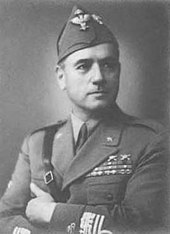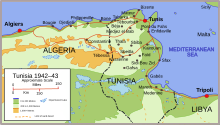Battle of Wadi Akarit
| Battle of Wadi Akarit | |||||||
|---|---|---|---|---|---|---|---|
| Part of the Second World War | |||||||
 Gabès and the Tunisian Campaign. | |||||||
| |||||||
| Belligerents | |||||||
|
|
| ||||||
| Commanders and leaders | |||||||
| Bernard Montgomery | Giovanni Messe | ||||||
| Strength | |||||||
| 3 divisions | 24,500 (estimated) | ||||||
| Casualties and losses | |||||||
|
1,289 32 tanks | 7,000 prisoners | ||||||
The Battle of Wadi Akarit (Operation Scipio) was an
Background
After the
Prelude
Wadi Akarit lay on an east–west line, from the Mediterranean Sea in the east and the impassable salt marshes at Sebkret el Hamma (the east end of the Chott el Djerid) to the west. There were no flanks to turn as there had been at the Tebaga Gap and no opportunity to disperse the defenders by attacking at several points, as at the Second Battle of El Alamein; a frontal attack on prepared defences was unavoidable.[3] From the coast, the defence line followed Wadi Akarit for 5 miles (8.0 km), which was impassable to armour and then a wider section of dry wadi, backed by a long hill, Djebel er Roumana, the last of a line of high ground that forms the northern boundary of the Chott. The approaches to Djebel er Roumana were obstructed by an anti-tank ditch and there were more defence works to the west, although the broken ground was a significant obstacle.[4]
Battle

Allied advance units had advanced through
Eighth Army had spent the previous week regrouping ready for the assault whilst the enemy was pounded almost continually by British and American air forces.
— Ford[6]

Instead of attacking between Jebel Fatnassa, a steep 800-foot (240 m) hill and the junction with the 50th (Northumbrian) Division,

The 50th (Northumbrian) Division met determined resistance from Italian marines, well dug in at Wadi Akarit and plentifully supplied with automatic weapons and grenades but the British pressed forward, despite high casualties among the 6th Battalion, Green Howards; two senior officers, six senior NCOs and junior officers and 118 other ranks were killed.[9][10]
When we were about ten yards away we had reached the top of the slit trench and we killed any of the survivors.... It was no time for pussy footing, we were intoxicated with rage and had to kill them to pay for our fallen pal.
— Bill Cheall[9]
The Green Howards took Point 85 and held it against counter-attacks. The 1/4th Battalion Essex Regiment of the 4th Indian Division made contact with the 50th (Northumbrian) Division on the right flank and helped them to cross an anti-tank ditch.[11]
The 51st (Highland) Division attacked with the 152nd Brigade and seized the top of Roumana, then made a gap through the minefield and the anti tank ditch on the left flank. The 153rd and 154 brigades attacked the coastal defences and took 2,000 prisoners.[12] A battalion of the 101st Motorised Division Trieste was destroyed and prisoners were taken from the 90th Light Afrika Division, one regiment of which counter-attacked at 9:00 a.m. and caused a short delay before being repulsed.[13]
1st Italian Army counterattack

Messe ordered the 164th Leichte Afrika Division to move from the position in the western hills to the centre and in the afternoon sent the 15th Panzer Division to join with the 90th Light Division and counter-attack the 101st Motorised Division Trieste positions captured by the 51st (Highland) Division. The 15th Panzer Division arrived just before the British tried to exploit their success and counter-attacked. (The 10th and 21st Panzer divisions, which had been opposite the US II Corps during the Battle of El Guettar were also moved towards the British attack.)[14]
Three German counter-attacks were made during the afternoon, mainly against the 51st (Highland) Division on Djebel Roumana, against positions held by the 7th Battalion,
Axis retreat
The 2nd New Zealand Division and 1st Armoured Division began a pursuit across the coastal plain, which changed from semi-desert to olive groves which offered opportunities for ambush. There was little resistance until close to Enfidaville and about 6,000 prisoners were taken, sometimes surprised to see Allied troops beyond the supposed front line and large amounts of material (including captured American supplies) were taken.[17]
Aftermath
Casualties
At dawn on 7 April, it was found that the Axis forces had quietly withdrawn. The 15th Panzer Division had suffered many losses, the 164th Leichte Afrika Division had lost most of its weapons and vehicles and at least three Italian divisions had to be amalgamated into one unit; the 80th Infantry Division La Spezia was reduced to 1+1⁄2 infantry companies, the 101st Motorised Division Trieste to three weak battalions and the 16th Motorised Division Pistoia and the 90th Light divisions had many casualties.
Subsequent operations

At El Guettar, the II US Corps operation to cut off Axis forces during the Wadi Akarit attack had been held up but the retirement from Wadi Akarit forced the Italians to withdraw. On 7 April, the Americans raced down the El Guettar–Gabès road, where it met advanced troops of the Eighth Army at 5:00 p.m.[21] Alexander moved the II US Corps to the north, because the Eighth Army was better prepared for the final offensive.[22] The pursuit covered 140 miles (230 km) north of Wadi Akarit, Sfax and Sousse were captured. The Axis troops fell back to defensible positions north and west of Enfidaville, 25 miles (40 km) south of Cape Bon. The mountains descend to the sea, with a narrow passage to Hammamet. The area was held until the Axis surrender in north Africa and Eighth Army units were moved towards Medjez el Bab opposite Tunis, for the final operations of the Tunisian Campaign.[23][24]
Order of battle
British Eighth Army
(Allied units taken from Playfair et al. (1966) unless indicated)[25]
- XXX Corps
- 50th (Northumbrian) Infantry Division (69th Infantry Brigade, less 151st Infantry Brigade, att: 1st Free French Brigade and 1st Greek Infantry Brigade)
- 51st (Highland) Infantry Division
- 4th Indian Division
- 2nd New Zealand Divisional Artillery[26]
- Held in reserve to exploit the breakthrough[27]
- 2nd New Zealand Division, including the Greek Sacred Band special forces unit
- 1st Armoured Division
Italian 1st Army
(Axis units taken from Playfair et al. (1966) unless indicated)[28][a]
- XX Army Corps
- 101st Motorised Division "Trieste"
- 136th Armoured Division "Giovani Fascisti"
- German 90th Leichte Afrika Division (less one regiment)
- XXI Army Corps
- 16th Motorised Division "Pistoia"
- 80th Infantry Division "La Spezia"
- German 164th Leichte Afrika Division
- one regiment 90th Leichte Afrika Division
- German 15th Panzer Divisionin reserve
Notes
- Afrikakorps.[19]
See also
- List of British military equipment of World War II
- List of German military equipment of World War II
- List of Italian Army equipment in World War II
Footnotes
- ^ Lewin 2004, p. 192.
- ^ Playfair et al. 2004, pp. 357–362.
- ^ Playfair et al. 2004, pp. 363–364.
- ^ Playfair et al. 2004, p. 362.
- ^ Murphy 2008, pp. 490–492.
- ^ a b Ford 2012, p. 90.
- ^ Playfair et al. 2004, pp. 364–366.
- ^ Playfair et al. 2004, pp. 369–373.
- ^ a b Cheall 1994.
- ^ Playfair et al. 2004, pp. 364–367, 372–373.
- ^ Playfair et al. 2004, pp. 370, 372.
- ^ Delaforce 2006, pp. 88–94.
- ^ Stevens 1962, pp. 262–265.
- ^ Ford 2012, pp. 87–91.
- ^ Playfair et al. 2004, pp. 372.
- ^ Playfair et al. 2004, pp. 373–374.
- ^ Hunt 2014, p. 172.
- ^ Playfair et al. 2004, p. 375.
- ^ a b Stevens 1962, p. 254.
- ^ Ford 2012, p. 91.
- ^ Playfair et al. 2004, pp. 357–358, 376.
- ^ Strawson 2004, p. 209.
- ^ Loughnan 1963, pp. 283–288.
- ^ Lewin 2004, pp. 246–247.
- ^ Playfair et al. 2004, p. 485.
- ^ Murphy 2008, pp. 491–492.
- ^ Loughnan 1963, pp. 278–285.
- ^ Playfair et al. 2004, p. 363.
Bibliography
- Cheall, Bill (May 1994). "The War of a Green Howard, 1939–1945. Bill Cheall's Story". The Friends of the Green Howards. Archived from the original on 11 October 2007. Retrieved 9 April 2008.
- Delaforce, Patrick (2006). Monty's Highlanders: 51st Highland Division in the Second World War. Philadelphia, PA: Casemate. ISBN 978-1-84415-512-5.
- Ford, Ken (2012). The Mareth Line 1943: The End in Africa. Osprey Military Campaign Series. Oxford: Osprey. ISBN 978-1-78096-093-7.
- Hunt, David (2014) [1966]. A Don at War (2nd Routledge ed.). London: William Kimber. ISBN 978-1-13522-386-1.
- ISBN 1-84415-040-2.
- Loughnan, R. J. M. (1963). Divisional Cavalry. The Official History of New Zealand in the Second World War 1939–1945 (New Zealand Electronic Text Collection ed.). Wellington, NZ: Historical Publications Branch, Department of Internal Affairs. OCLC 195420. Retrieved 10 March 2015.
- Murphy, W. E. (2008) [1966]. 2nd New Zealand Divisional Artillery. The Official History of New Zealand in the Second World War 1939–1945 (New Zealand Electronic Text Collection OCLC 460192. Retrieved 10 March 2015.
- Playfair, I. S. O.; Molony, C. J. C.; Flynn, F. C.; Gleave, T. P. (2004) [1966]. Butler, J. R. M. (ed.). The Mediterranean and Middle East: The Destruction of the Axis Forces in Africa. History of the Second World War United Kingdom Military Series. Vol. IV (facs. repr. Naval & Military Press ed.). London: ISBN 1-84574-068-8.
- Stevens, Major-General W. G. (1962). Bardia to Enfidaville. The Official History of New Zealand in the Second World War 1939–1945 (New Zealand Electronic Text Collection ed.). Wellington, NZ: War History Branch, Department of Internal Affairs. OCLC 4377202. Retrieved 10 March 2015.
- Strawson, Jon (2004). The Battle for North Africa. Barnsley: Pen and Sword. ISBN 978-1-47381-898-9.
Further reading
- Barnes, B. S. (2007). Operation Scipio: The 8th Army at the Battle of the Wadi Akarit, 6th April 1943. Market Weighton, N. Yorks: Sentinel Press. ISBN 978-0-9534262-2-5.
- Jeffreys, Alan; Rose, Patrick (2012). The Indian Army, 1939–47: Experience and Development. Farnham: Ashgate. ISBN 978-1-40945-653-7.
- ISBN 0-552-10921-5.
- Moreman, T. R. (2007). Desert Rats: British 8th Army in North Africa 1941–43. Battle Orders. Oxford: Osprey. ISBN 978-1-84603-144-1.
- ISBN 0-304-36705-2.
- ISBN 1-84513-115-0.
- Neillands, R. (2004). Eighth Army: From the Western Desert to the Alps. London: John Murray. ISBN 0-7195-5647-3.
External links
- Bardia to Enfidaville (NZ Official History) The Attack at Akarit
- 2nd New Zealand Divisional Artillery account
- Italy's Marines
